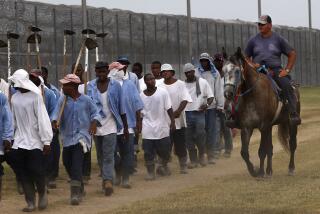Florida Revives Chain Gangs, After 49 Years
- Share via
MIAMI — For the first time since 1946, Florida prisoners were forced to work in chain gangs Tuesday, hacking away at melaleuca trees that are choking the Everglades.
Twenty prisoners from the South Florida Reception Center cut and cleared a small patch, watched by prison officials, reporters and Republican state Sen. Charlie Crist, nicknamed “Chain Gang Charlie” because he wrote the bill reviving the forced labor.
“What we want to do is tell people that if you commit a crime in Florida, if you’re convicted of committing that crime in Florida, Florida will punish you, you will do your time and it will not be pleasant,” Crist said.
At a time of growing public anger over crime, Florida became the third state to bring back the form of forced labor that was eradicated nationwide in the 1940s because it was considered inhumane.
Many likened it to slavery; some still do.
Unlike Alabama, Florida prisoners aren’t shackled together. Instead, each prisoner’s ankles are chained together and their 20-person work groups are monitored by three guards. Arizona has introduced a similar system.
Chain gangs are being used as punishment for breaking prison rules. Those chosen may be maximum-security inmates, but none will be sex offenders, prior escapees, first-degree murderers or the physically or mentally ill. So far, no women are scheduled for the details.
No sunscreen during 10-hour days under the scorching Florida sun. No bug repellent in the mosquito-infested Everglades.
Just water, baseball caps, gardening gloves and thick leather pants to guard against snake bites.
“Of course, I don’t want to be there with my legs chained,” said Bryan Brunett, who is serving 12 years for attempted armed robbery and was assigned to the chain gang for fighting with another inmate.
“I feel it’s against my constitutional rights. I don’t mind working, it’s just the fact of having chains on my ankles and being strip-searched.”
Stan W. Czerniak, assistant secretary for operations at the Department of Corrections, said he was unsure chain gangs would be the deterrent Crist wants and questioned whether they were worth the increased manpower necessary.
Inside the prisons, two guards can oversee up to 144 inmates. On the chain gangs, three guards are needed to supervise a crew of 20 prisoners.
More to Read
Sign up for Essential California
The most important California stories and recommendations in your inbox every morning.
You may occasionally receive promotional content from the Los Angeles Times.













